Last updated on July 14th, 2024 at 05:06 pm
Magnetic Effects Of Electric Current Notes
Below are some of the very important NCERT Class 10 Science chapter 13 Magnetic Effects Of Electric Current Notes And Questions Answers. These Class 10 Magnetic Effects Of Electric Current Notes And Questions Answers have been prepared by expert teachers and subject experts based on the latest syllabus and pattern of term 2. Questions with Answers to help students understand the concept.
These Questions for Class 10 Science Magnetic Effects Of Electric Current Notes And Questions Answers are very important for the latest CBSE term 2 pattern. These class 10 notes and Q and A are very important for students who want to score high in CBSE Board.
We have put together these NCERT Questions of Class 10 Science chapter 13 Magnetic Effects Of Electric Current Notes And Questions Answers for practice on a regular basis to score high in exams. Refer to these Questions with Answers here along with a detailed explanation.
In 1820, Christian Oersted discovered that a compass needle gets deflected when a current carrying metallic conductor is placed nearby it. He concluded that the deflection of the compass needle was due to the magnetic field produced by the electric current.
Hence, it was deduced that electricity and magnetism are related to each other.


Magnetic Field
It is the space around a magnet in which its effect can be experienced i.e. its force can be detected. It is a vector quantity. The SI unit of magnetic field is Tesla.
Magnetic Lines of Force
They are the imaginary lines representing the magnetic field around a magnet. When iron filings are kept near a magnet, they get arranged in a pattern which represents the magnetic field lines.


A compass needle behaves as a small bar magnet whose one end points towards North and other end towards South.
Properties of Magnetic Field Lines
The magnetic field lines have the following properties
- They originate from the North pole of a magnet and end at its South pole, by convention.
- These lines are closed and continuous curves.
- They are crowded near the poles, where the magnetic field is strong and separated far from the poles, where the magnetic field is weak.
- Field lines never intersect with each other. If they do, that would mean that there are two directions of the magnetic field at the point of intersection, which is impossible.
Magnetic Field due to a Current Carrying Conductor
When electric current flows through a metallic conductor, a magnetic field is produced around it.
Different magnetic field patterns are produced by current carrying conductors of different shapes.
Magnetic Field due to a Current through a Straight Conductor
The magnetic field lines around a current carrying straight conductor are concentric circles whose centers lie on the wire.
Magnitude of magnetic field B produced by a straight current carrying wire at a given point is
(i) Directly proportional to thc current I passing through the wire,
B ∝ 1
(ii) Inversely proportional to the distance r from the current carrying conductor.


By using Eqs. (i) and ((ii), we get B ∝ l / r
If the direction of current in a straight wire is known then the direction of magnetic field produced by it is obtained by Maxwell’s Right Hand Thumb Rule
Maxwell’s Right Hand Thumb Rule
It states that if you hold the current carrying straight wire in the grip of your right hand in such a way that assisted thumb points in the direction of current then the direction of the girl of the fingers were give the direction of the magnetic field this rule is also called maxwell’s corkscrew rule.


Magnetic Field due to a Current through a Circular Loop
The magnetic field lines due to a circular coil are shown in the given figure,
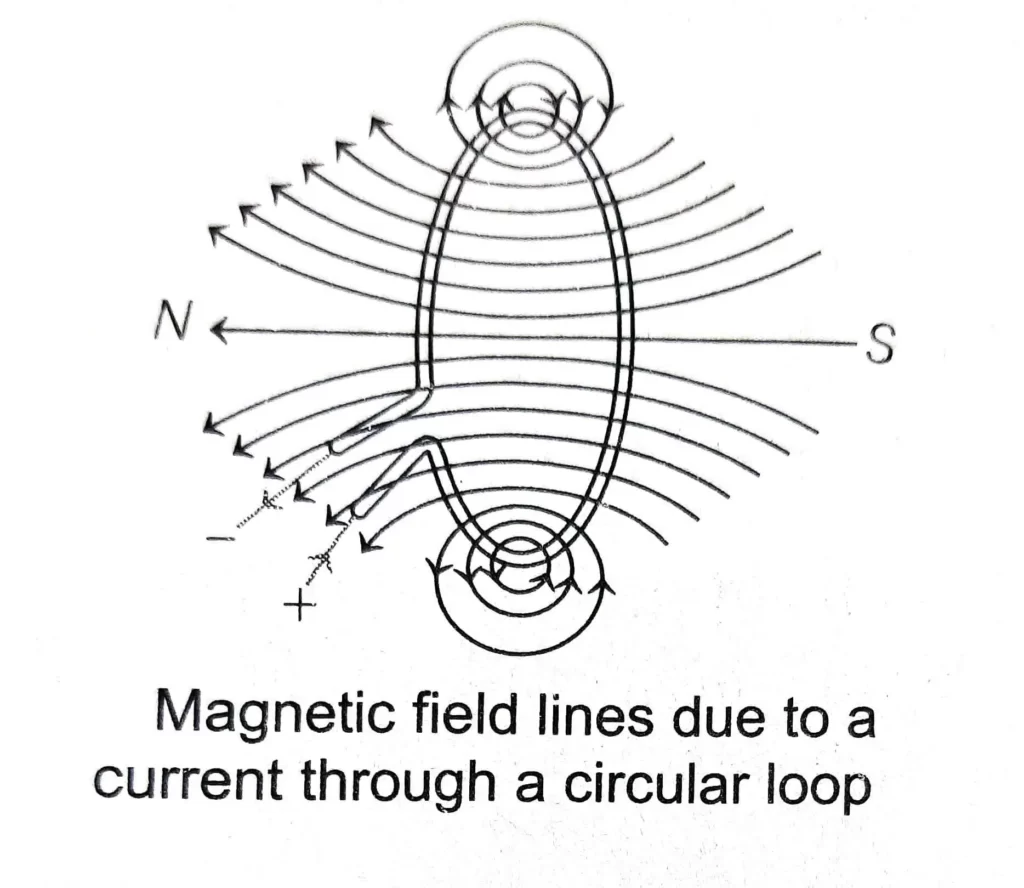

At every point on a current carrying circular loops the magnetic field is in the Ibrm of concentric circles around it. As we move away from it, the circles would become larger and larger.
When we reach the center of the loop, the field appears to be a straight line. The magnetic field produced by current carrying circular wire at a given point is
(i) Directly proportional to the amount of current (I) passing through it
i.e. B ∝ I
(ii) Directly proportional to the number of turns (N) of the Mire,
i.e. B ∝N
This is because the current in each turn is in the same direction. Therefore, the field due to these turns get added up.
Thus, the strength of magnetic field produced by a current carrying circular coil can be increased by
- increasing the number of turns of the coil
- increasing the current flowing through the coil
Magnetic field due to current in a solenoid
A solenoid is defined as a coil consisting of a large number of circular turns of insulated copper wire this terms are wrapped closely to form a cylinder


The field lines around a current carrying solenoid are similar to that produced by a bar magnet. This means that a current carrying solenoid behaves as if it has a North pole and a South pole. The field lines inside the solenoid are parallel to each other.
Thus, the strength of the magnetic field is the same, i.e. uniform at all points inside a solenoid.
Click Below For All Class 10 Subjects Sample Papers 2024
The strong magnetic field produced inside a solenoid can be used to magnetize a piece of magnetic material like soft iron when placed inside the coil. The magnet so formed is called electromagnet.
The magnetic effect remains only till the current is flowing through the solenoid.
An electromagnet is used in electric bells, electric motors, telephone diaphragms, loudspeakers and for sorting scrap metal.


Force on a Current Carrying Conductor in a Magnetic Field
When a current carrying conductor is placed in a magnetic field, it experiences a force. The force acting is due to interaction between the magnetic field produced by the current carrying conductor and the external magnetic field in which the conductor is placed.
The direction of force on the conductor depends on the following factors
(i) Direction of current The direction of force on the conductor can be reversed by reversing the direction of current.
(ii) Direction of magnetic field The direction of force on the conductor can be reversed by reversing the direction of magnetic field by interchanging the position of poles.
Force on the conductor is maximum when the direction of current is at right angles to the direction of the magnetic field.
Fleming’s Left Hand Rule
The direction of force which acts on a current carrying conductor placed in a magnetic field is given by Fleming’s left hand rule.
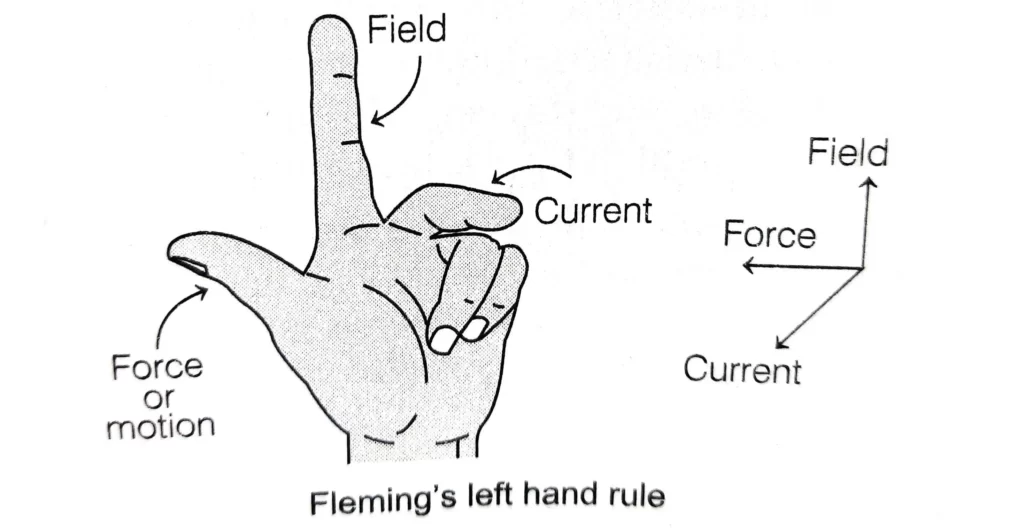

It states that, if the forefinger, thumb and middle finger of left hand are stretched mutually perpendicular to each other, such that the forefinger points along the direction of external magnetic field, middle finger indicates the direction of current, then the thumb points towards the direction of force acting on the conductor.
Electric Motor
It is a rotating device used for converting electric energy into mechanical energy.
Principle
It is based on the, a rectangular coil is placed in a field and is passed it, two equal and opposite forces act on the coil which rotate it continuously.
Construction
It consists of a rectangular coil, connected to a source of current and a switch.
The commutators R1 and R2 are fixed to the coil and pressed tightly against the brushes X and Y.
The function of the commutator is to reverse the direction of current flowing through the coil, after every half rotation. In an electric motor, split rings act as commutators.
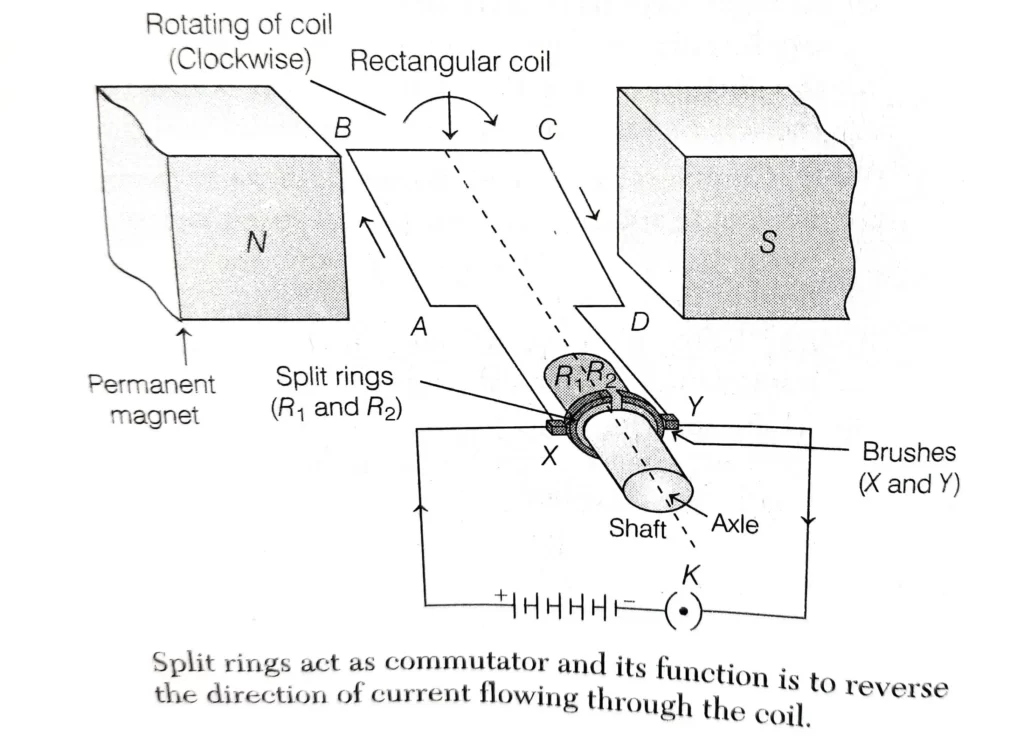

Working
- Let coil ABCD be in horizontal position. When the key is closed, the current flows in the coil ABCD through brush X and flows back to the battery through the brush Y via ring R2.
- No force acts on arms BC and AD as they are parallel to the magnetic field. Arm AB experiences a force in downward direction and arm CD experiences an equal force in upward direction.
- The direction of force is obtained by applying Fleming’s left hand rule. This causes the coil to rotate in the anti-clockwise direction.
- When the rotating coil is in the vertical position, the brushes lose contact with the rings and current stops flowing. But the coil does not stop due to inertia of motion.
- When the coil rotates, the rings change their positions and come in contact with opposite brushes.
- This reverses the direction of current through the coil but the direction of current on right hand side of the coil remains the same.
- So, the force on the right hand side is always upwards and the force on the left hand side is always in the downward direction. Thus, the coil continues to rotate in an anti-clockwise direction.
The speed of rotation of the motor can be increased by
- increasing the strength of tho current in the coil.
- increasing the number of turns in the coil.
- increasing the area of the coil,
- increasing the strength of the magnetic field.
Click Below To Learn Science Syllabus All Chapters
- Chapter 4: Carbon And Its Compounds Notes / Questions
- Chapter 5: Periodic Classification of Elements Notes / Questions
- Chapter 8: How Do Organism Reproduce Notes / Questions
- Chapter 9: Heredity And Evolution Notes / Questions
- Chapter 12: Electricity Notes / Questions
- Chapter13: Magnetic Effects of Electric Current Notes / Questions
- Chapter15: Our Environment Notes / Questions
Click Below For All Class 10 Subjects Sample Papers 2024
Commercial Electric Motor
It has the following components e
- An electromagnet in the place of permanent magnet.
- A large number of turns of conducting wire in the current carrying coil.
- A soft iron core on which the coil is wound. The combination of soft iron core and coil is called armature, It enhances the power of motor.
- Electric motors are used in electric fans, refrigerators, mixers, washing machines, computers, MP3 players, etc.
Electromagnetic Induction
Production of an electric current in a closed circuit by a changing magnetic field is called an induced current. This phenomenon is called electromagnetic induction.
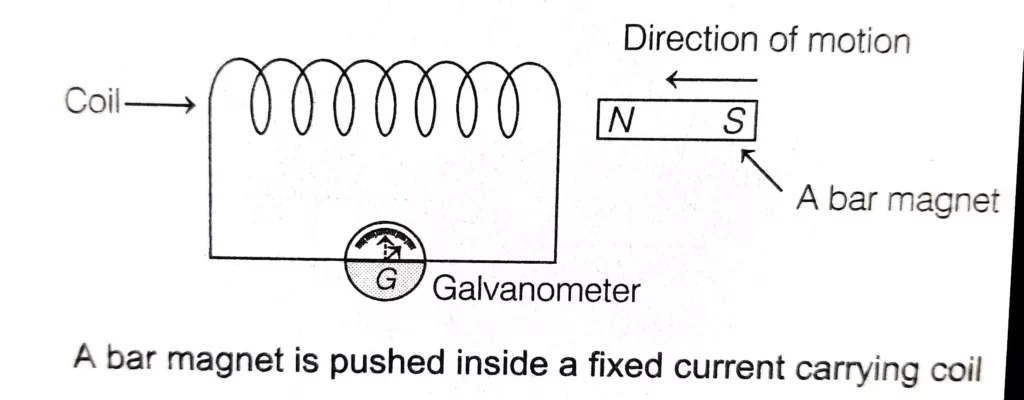

Fleming’s Right Hand Rule
The direction of induced current is given by Fleming’s right hand rule. It states that, if the forefinger, ‘middle finger and thumb ofthe right hand are stretched at right angles to each other, with the forefinger in the direction of the magnetic field and the thumb in the direction of the motion of the wire, then the induced current in the wire is in the direction of the middle finger.
Ways to Induce Current in a Circuit
There are different methods by which current can be induced in a circuit
(i) By Moving a Coil in a Magnetic Field Current can be induced in the coil either by moving it in a magnetic field or by changing the magnetic field around it as indicated by deflection in the galvanometer needle.
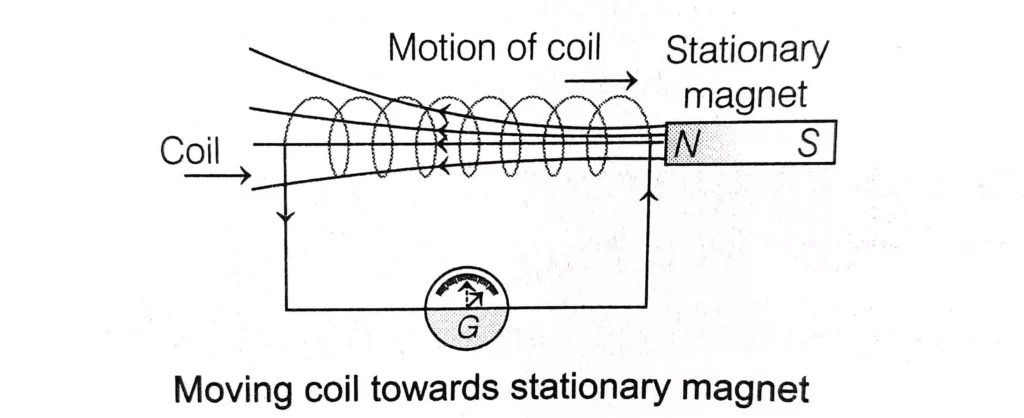

The induced current is the direction of motion to the magnetic field.
The direction of induced current can be reversed by reversing the direction of the magnetic field. If the coil as well as the magnet are stationary, then no current is induced in the coil.
(ii) By Changing the Magnetic Field Around a Nearby Coil Consider two coils, where coil 1 is called as primary coil and coil 2 as secondary coil. Primary coil is connected to a battery.
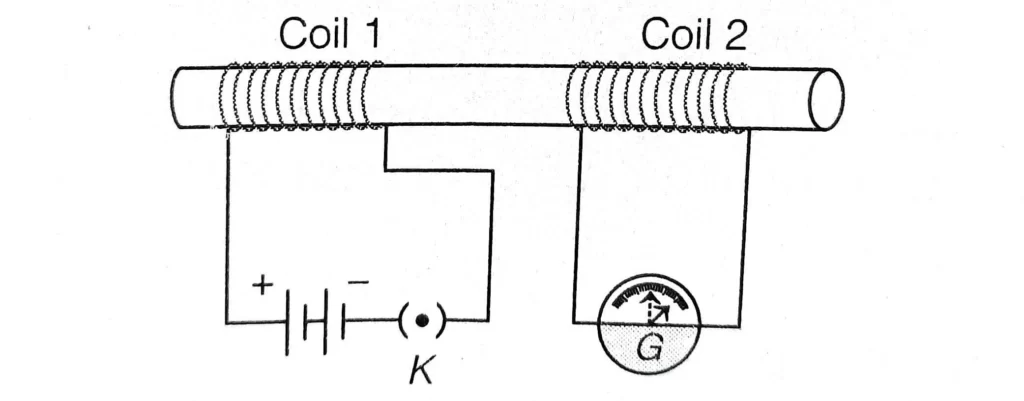

When the key (K) is closed, the current in the primary coil takes a little time to rise from zero to a maximum value. This causes a momentary change in the magnetic field around this coil. This induces a momentary current in the secondary coil.
The same happens in the reverse direction when the key (K) is opened. Current is induced in coil 2 when current in coil 1 is changed which is indicated by the deflection in the galvanometer needle.
Frequently Asked Questions
Short Answer Type Questions
1. List the properties of magnetic lines of force. Why do two magnetic lines of force not intersect with each other? (NCERT)
2. The following diagram shows two parallel straight conductors carrying the same current. Copy the diagram and draw the pattern of the magnetic field lines around them showing their directions.x What is the magnitude of magnetic field at a point X which is equidistant from the conductors? Give justification for your answer. (CBSE 2019)
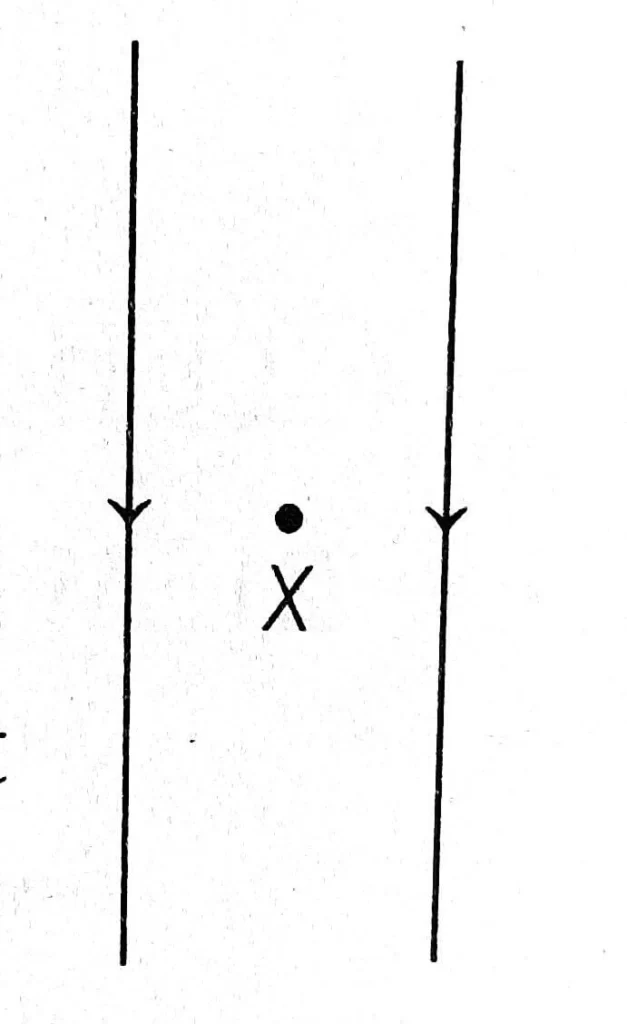

3. How will the strength of the magnetic field change when the point where the magnetic field is to be determined is moved away from the straight wire carrying constant current? Justify your answer. (CBSE 2019)
4. AB is a current carrying conductor in the plane of the paper as shown in figure. What are the directions of magnetic fields produced by it at points P and Q?


Given r1 > r2, where will the strength of the magnetic field be larger? (NCERT Exemplar)
5. A horizontal power line carries a current from East to West direction. What is the direction of the magnetic field due to the current in the power line at a point above and at a point below the power line?
6. A circular loop carrying a current is placed on a horizontal surface (current is in the clockwise direction).
What is the direction of its magnetic field at the center? What is the direction of the magnetic field at a point outside the surface of the loop?
7. Find the direction of magnetic field due to a current carrying circular coil held
(i) Vertically in the North-South plane and an observer looking for it from East sees the current to flow in anti-clockwise direction.
(ii) Vertically in the East-West plane and an observer looking from the South sees the current to flow in an anti-clockwise direction.
(iii) Horizontally and an observer looking at it from below sees current to flow in a clockwise direction.
8. How does a solenoid behave like a magnet? Can you determine the North and South poles of a current carrying solenoid using a bar magnet? Explain. (NCERT)
9. Give reasons for the following
(i) There is either a convergence or a divergence of magnetic field lines near the ends of a current carrying straight solenoid.
(ii) The current carrying solenoid when suspended freely rests along a particular direction.
(iii) The strength of the magnetic field is uniform inside a solenoid. (CBSE 2020)
10. When is the force experienced by a current carrying conductor placed in a magnetic field largest? Which rule determines the direction of force on the current carrying conductor?
11. A magnetic field is non-uniform but its direction is constant (East to West) is set-up in a chamber. A charged particle enters the chamber and travels undeflected along a straight path with constant speed.
What do you say about the initial velocity of the particle?
12. An α -particle (positive charge) enters a uniform magnetic field at right angles to it as shown below.
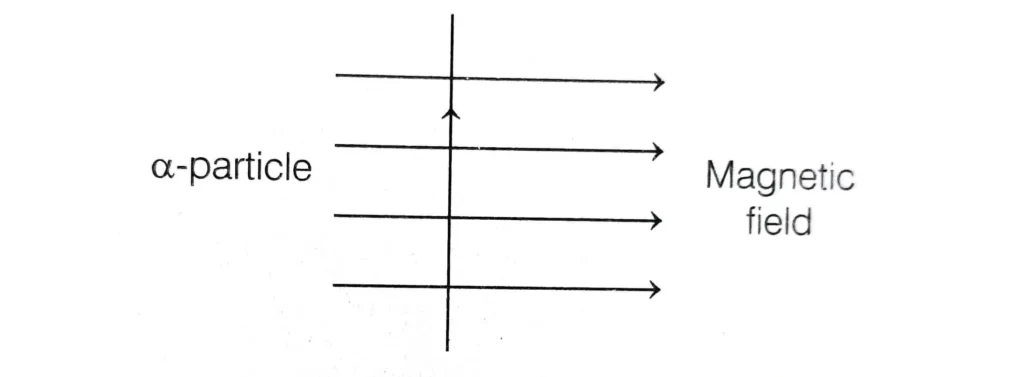

a-particleMagnetic field
In which direction a-particle moves, if the direction of the magnetic field gets reversed?
13. State whether an α-particles will experience any force in a magnetic field, if (α-particles are positively charged particles).
(i) It is placed in the field at rest.
(ii) It moves in the magnetic field parallel to field lines.
(iii) It moves in the magnetic field perpendicular to field lines.
Justify your answer in each case,
Click Below For All Class 10 Subjects Sample Papers 2024
14. The electron enters a uniform magnetic field in three different ways as shown below.


Identify the case in which the force on electrons will be maximum and minimum, respectively. Give reasons for your answer. Find the direction of maximum force acting on electrons.
15. The figure shows the split ring commutator and the two carbon brushes in their respective positions.


What can you say about carbon brush and split ring commutators?
16. Sketch the schematic diagram of an electric motor. What is the role of split rings in an electric motor? (NCERT)
17. (i) In what ways does the speed of rotation of an electric motor increase?
(ii) Name some devices in which electric motors are used. (NCERT)
18. A circular metallic loop is kept above the wire AB as shown below.


What is the direction of induced current produced in the loop, if the current flowing in the straight wire
(i) is steady, i.e. does not vary?
(ii) is increasing in magnitude?
Justify your answer in each case.
19. In the arrangement shown in figure there are two coils wound on a non-conducting cylindrical rod. Initially the key is not inserted in the circuit. Later the key is inserted and then removed shortly after.


What are the two observations that can be noted from the galvanometer reading?
20, (i) A coil of insulated wire is connected to a galvanometer. What would be observed if a strong bar magnet with its south pole towards one face of the coil is
(a) moved quickly towards it?
(b) moved quickly away from it?
(c) held stationary near it?
(ii) Name the phenomenon involved. (CBSE 2020, NCERT)
Long Answer Type Questions
21. Why does a magnetic compass needle pointing North and South in the absence of a nearby magnet get deflected when a bar magnet or a current carrying loop is brought near it? Describe some salient features of magnetic lines of field concept. (NCERT Exemplar)
22. PQ is a current carrying conductor in the plane of the paper as shown in the figure below.
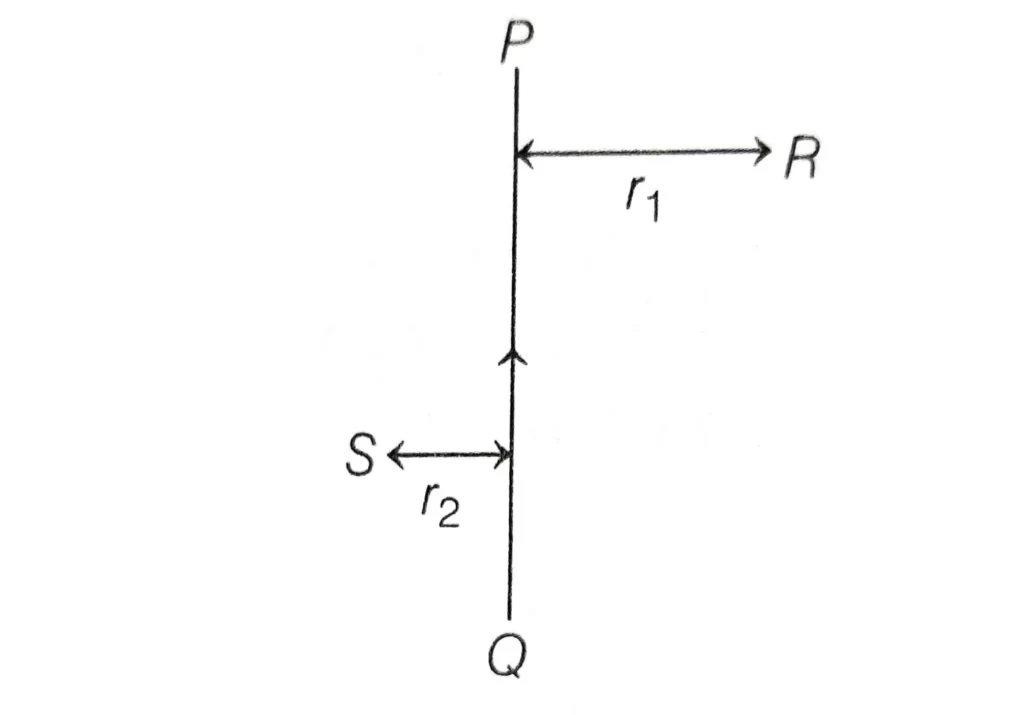

(i) Find the directions of the magnetic fields produced by it at points R and S.
(ii) Given r1 > r2, where will the strength of the magnetic field be larger? Give reasons.
(iii) If the polarity of the battery connected to the wire is reversed, how would the direction of the magnetic field be changed?
(iv) Explain the rule that is used to find the direction of the magnetic field for a straight current carrying conductor. (CBSE Sample Paper)
23. What is solenoid? Draw the pattern of magnetic field lines of (i) a current carrying solenoid and (ii) a bar magnet.
List two distinguishing features between the two fields. (CBSE Delhi, 2019)
24. (i) State Fleming’s left hand rule.
(ii) Write the principle of working of an electric motor,
(iii) Explain the function of the following parts of an electric motor.
(a) Armature (b) Brushes
(c) Split ring (CBSE 2018, NCERT)
25, (i) What is meant by electromagnetic induction? Name one device which works on the principle of electromagnetic induction.
(ii) Describe three different ways to produce induced current in a coil of wire.
Case Based Questions
26. Read the following and anSwer the questions from (i) to (v) given below
A bar magnet is moved in and out of a coil, i.e connected to a sensitive center zero meter as shown in the figure given below.
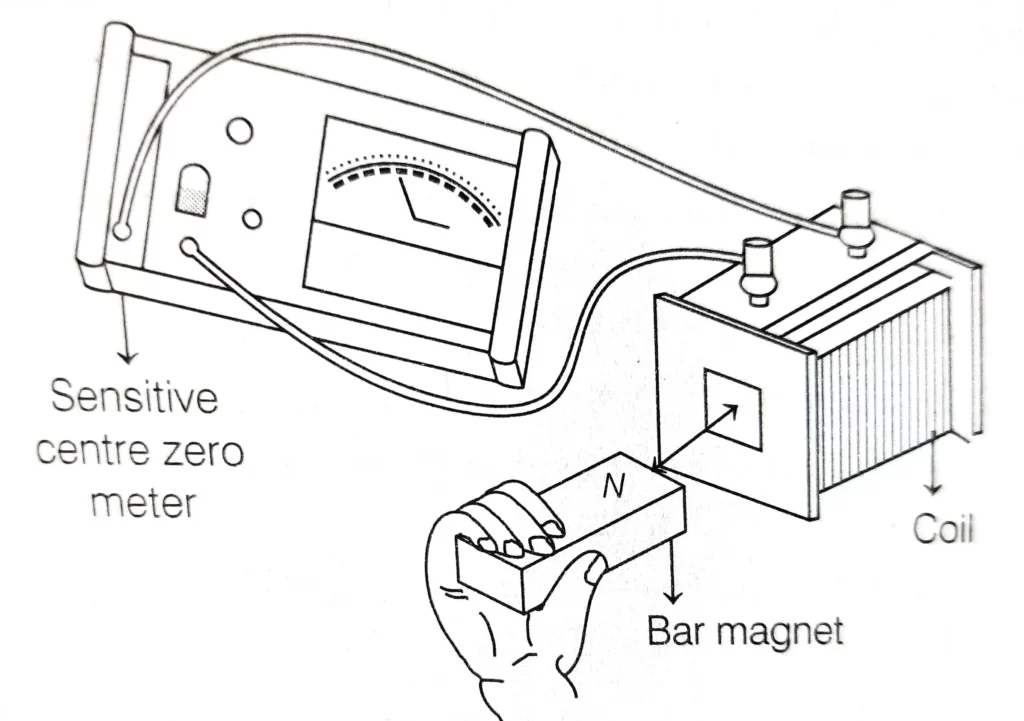

The meter niddle swings to the left when the magnet is moving towards the coil.
(i) How does the needle behaves when the bar magnet is at rest?
(ii) How does the needle behaves when the bar magnet is at rest and the coil is moving away from the magnet?
(iii) In which condition, the meter needle swings to the left?
(iv) Which phenomenon is involved in this?
(v) Give two applications based on the given phénomenon.
27. Read the following and answer the questions from (i) to (v) given below
A child performs an activity with a special material. He fixes a sheet of white paper on a drawing board using some adhesive material and places that material in the center of it.
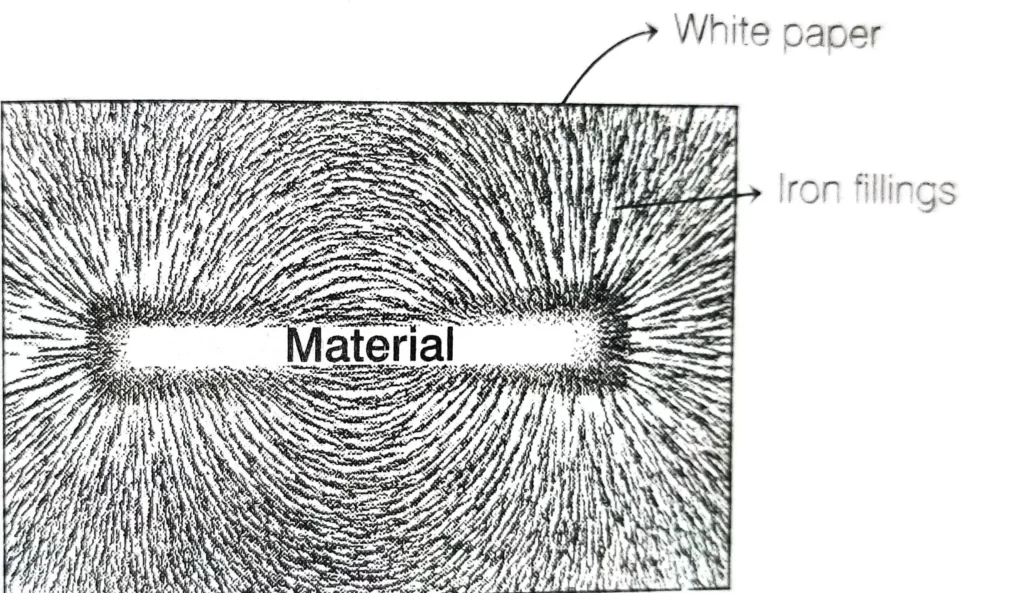

Then he sprinkles some iron fillings uniformly around it with a salt-sprinkler and taps the board gently.
(i) What type of material is placed on white paper?
(ii) Why do the iron fillings arrange in such a pattern ?
(iii) What should we call the region in which magnetic force enn be detected?
(iv) What do the lines on the pattern demonstrate?
(v) Does the degree of closeness of the field lines relate something?
28. Read the following and answer the questions from (i) to (v) given below
Jay performs an experiment by using two different coils of copper wire having different numbers of turns.
He inserted them over a non conducting cylindrical roll as shown.
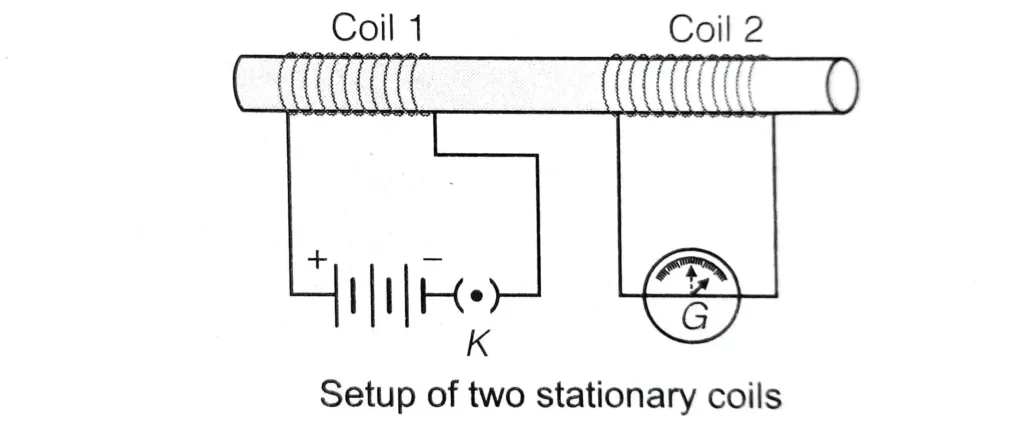

Then he connects the coil-1, having a large number of turns in series with a battery and plug key and other coil-2 with a galvanometer.
As he plugs the key, he observes some deflection in the galvanometer.
(i) Why is there a deflection in the galvanometer when a key is inserted in the circuit ?
(ii) When there is flow of induced current through a coil ?
(iii) Jay disconnected coil-I from the battery and noted the following observation.
“The needle momentarily moves but to the opposite direction”. Justify the statement.
(iv) When will the induced current is found to be highest?
(v)
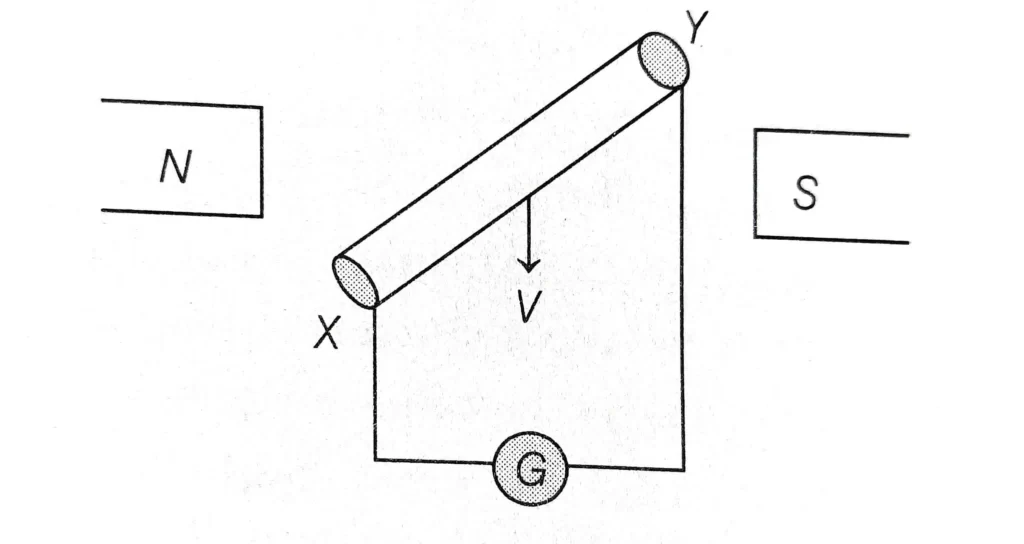

A conducting rod XY moves across two magnets as shown and the needle in the galvanometer gets deflected momentarily. What is the name of this physical phenomenon?
Click Below For All Class 10 Subjects Sample Papers 2024
Answers.
1. The properties of magnetic field lines are
(i) They originate from the North pole of a magnet and end at its South pole.
(ii) They are closed and continuous curves, (iii) They never intersect each other.
(iv) They are uniform inside the magnet.
If two magnetic field lines intersect each other, then at the point of intersection, there will be two directions of magnetic field lines, which is not possible. Hence, the magnetic field lines never intersect with each other.
2. Magnetic field lines due to parallel current carrying conductors are shown in figure.
Magnetic field at X will be zero as both conductors are equal in magnitude and are opposite in direction.
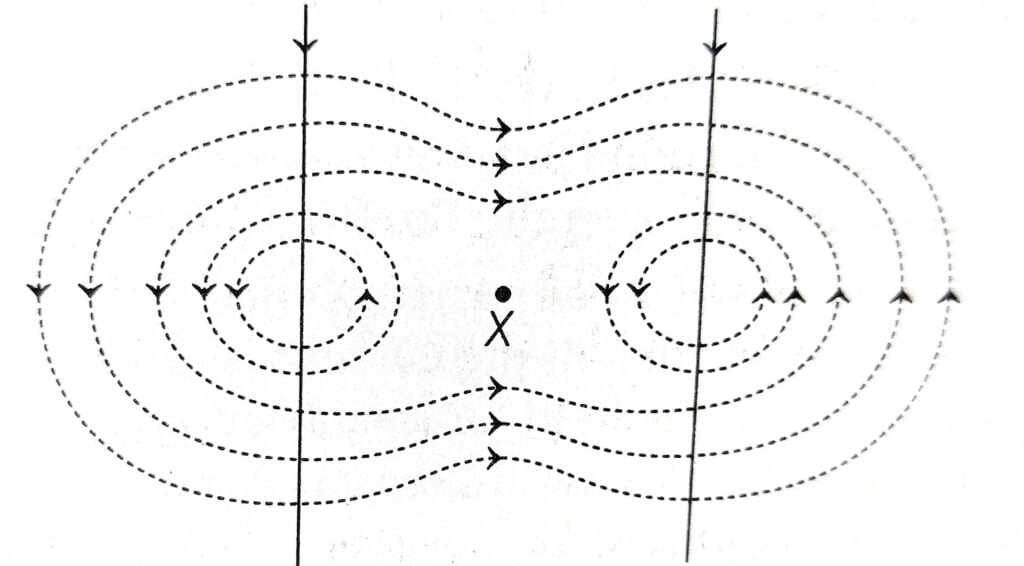

3. The strength of the magnetic field is inversely proportional to the distance i.e.
B ∝ 1/ r
As the point where the magnetic field is to be determined is moved away from the straight wire carrying constant current, the magnetic field strength decreases.
4. According to the right hand thumb rule, the magnetic field at P is directed into the plane of paper and at Q, it is out of the plane of paper. The strength of the magnetic field at Q will be larger as strength of the field
∝ 1 / r (distance)
Here, r1 > r2
Bl < B2 i.e. B2 has a larger field.
5. According to right hand thumb rule,


(i) The direction of the magnetic field at a point above the power line is from South to North.
(ii) The direction of the magnetic field at a point below the power Jine is from North to South.
6. The magnetic field lines are concentric circles at every point on a current carrying circular loop.
The direction of the magnetic field is determined by the right hand thumb rule. At the center of the circular loop, the magnetic field lines are straight and point towards the North.
The direction of magnetic field lines at the point outside the surface of the loop is shown below.
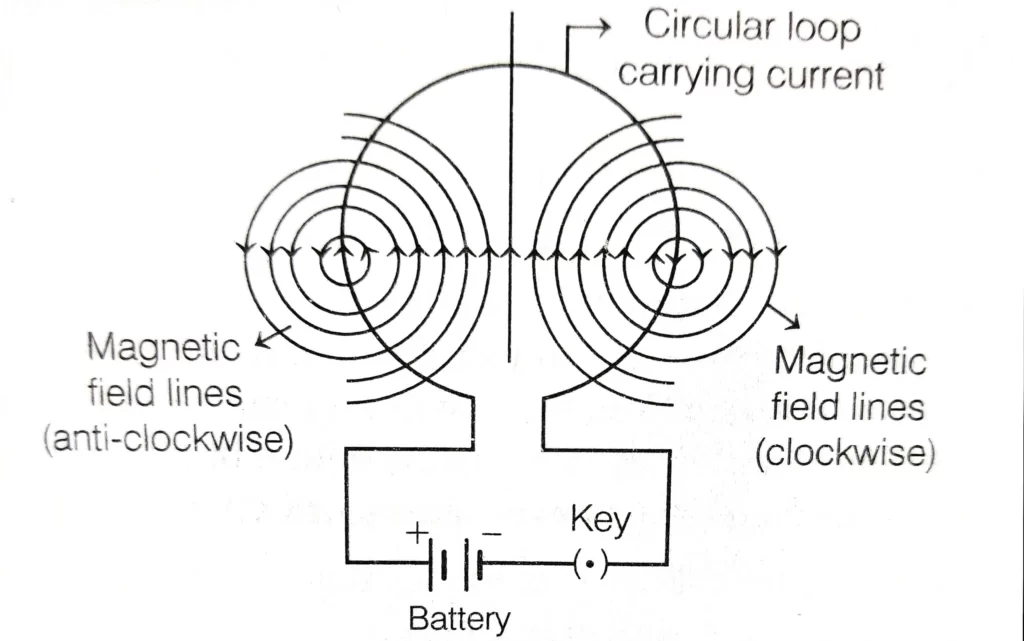

7. (i) When the coil is kept in the North-South plane and the current is flowing in the anti-clockwise through the loop, then the magnetic field is in the East to West direction.
(ii) When the coil is in a vertically East-West plane and current through the coil is in anti-clockwise direction, then the magnetic field is in the South to North direction.
(iii) When a circular coil carrying current is placed horizontally and the direction of the current is clockwise, then the direction of the field for the observer positioned below the coil is in the downward direction.
8. A solenoid behaves like a magnet when electric current passes through it.
One end of a solenoid behaves as a North pole and the other end behaves as a South pole. We can use a bar magnet to determine the North and South poles of a current carrying solenoid by using the property, i.e. like poles repel and unlike poles attract each other.
The end of the solenoid which attracts, North pole of a bar magnet is the magnetic South pole of the solenoid. The end of the solenoid which repels the North pole of a bar magnet is the magnetic North pole of the solenoid.
9. (i) The magnetic field lines are crowded (convergent) near the poles of solenoid. Hence, the magnetic field is strong and divergent, where the magnetic field is weak.
(ii) A freely suspended current carrying solenoid always points in the North-South direction even in the absence of any other magnet. Because the earth itself behaves as a magnet or solenoid to point always in a particular direction,
(iii) The field lines around a current carrying solenoid are similar to field lines of a bar magnet. So, inside the solenoid field lines are parallel to each other and the strength of the magnetic field is the same i.e. uniform at all points inside the solenoid.
10. The force experienced by a current carrying conductor placed in a magnetic field is the largest, when the conductor is kept perpendicular to the direction of the magnetic field.
Fleming’s left hand rule determines the direction of force on a current carrying conductor. It states that, if the forefinger (magnetic field), middle finger (current and thumb are stretched mutually, then the direction of force acting on the conductor is given by the thumb.
11. If a charged particle moves parallel or antiparallel to the magnetic field, no magnetic force will act on it and remains undeflected. So, in the given condition either the charged particle enters East to West or West to East as below.


12. Here, the force acting on the a-particle is directed pervendieular to the plane of paper in inward direction by Flenling’s left hand rule. If the direction of magnetic field gets reversed then the force will also act in opposite direction of a-particle i.e. the force experienced by a-particle is now in outward direction to the plane of paper.
13. (i) No, it will not experience any force. As, the magnetic field exerts force on a moving charged particle only.
(ii) No, it will not experience any force because the magnetic field exerts a force in the perpendicular direction to the motion of the particle.
(iii) Yes, it will experience a force in a direction perpendicular to the direction of its own motion and the direction of magnetic field can be determined by Fleming’s left hand rule.
14. Force on an electron is maximum in case (a), because here the direction of motion of the electron is perpendicular to the direction of magnetic field B.
Similarly, the force on an electron is minimum in case (c) because, in this case the direction of motion of the electron is along the direction of magnetic field B, as the electron is moving along B.
Hence, the direction of maximum force acting on an electron is perpendicular to the plane Of paper and directed into it.
15. When the gaps of the split ring commutator are aligned with the carbon brushes, then contacts are broken and the current is temporarily cut-off.
However, the coil keeps on rotating in the same direction due to its inertia until the split ring commutator and the carbon brushes are in contact again.
16. The schematic diagram of electric motor is shown below,


Split rings act as commutators and its function is to reverse the direction of current flowing through the coil.
17.(i) The speed of rotation of the motor can be increased by
- increasing the strength of the current in the coil.
- increasing the number of turns in the coil.
- increasing the area of the coil.
- increasing the strength of the magnetic field.
(ii) Electric motors are used in electric fans, refrigerators, mixers, washing machine, computers, MP3 player, etc.
18. (i) No induced current will be produced in the loop as the constant current flowing in the straight wire produces a constant magnetic field. Hence, no induced current is produced in the loop.
(ii) Since, current in the straight wire is changing, hence induced current will be produced in it. According to Fleming’s right hand rule, the current flowing in the loop will be in clockwise direction.
19. The observation that can be noted from the galvanometer reading are
(i) There are momentary galvanometer deflections that die out shortly.
(ii) The deflections are in opposite directions.
20.
(i) (a) Galvanometer gets deflected in one direction.
(b) Galvanometer gets deflection in opposite direction of the first one.
(c) Galvanometer shows no deflection.
(ii) Phenomenon involved is electromagnetic induction.
21. When a magnetic compass needle points North and South in the absence of a nearby magnet or a current loop, it is acting upon by the earth’s magnetic field only. But in the presence of a magnet or a current loop (which also has a magnetic field) the earth’s magnetic field near the compass is modified and the needle is deflected from North and South directions.
The salient features of magnetic field lines are
(i) A magnetic field line is directed from the North-pole to the South-pole outside the magnet.
(ii) A magnetic field line is a closed and continuous curve.
(iii) The magnetic field lines never intersect each other, because if two lines meet, it means that force is acting in two directions at that point which is not possible.
(iv) Closer the field lines, stronger is the magnetic field and vice-versa is also true.
(v) Magnetic field lines are parallel and equidistant, those represent a uniform magnetic field.
22. (i) According to right hand thumb rule, the magnetic field produced by PQ at point R is into the plane of the paper and at point S is out of the plane of paper,
(ii) Here, r1 > r2
The magnetic field will be larger al: point S as compared to that at point R.
This is because the magnetic field produced by a straight current-carrying conductor is inversely proportional to the distance the wire, So, the magnetic field will be larger at the point which is nearer to the conductor.
As, point S is nearer to the conductor as compared to point R. So, field at S > field at R
(iii) If the polarity of the battery is reversed, the current will be going from top to bottom in the wire and the magnetic field lines will now be in the clockwise direction on the plane, which is perpendicular to the wire carrying current.
(iv) Maxwell’s right hand thumb rule is used to find the direction of the magnetic field for a straight current carrying conductor.
This law states that, if you hold the current carrying straight wire in the grip of your right hand in such a way that the stretched thumb points in the direction of current, then the direction of the curl of the fingers will give the direction of the magnetic field.


Distinguishing features are as follows:
- Magnetic field outside the solenoid is negligible as compared to the bar magnet.
- Magnetic field of solenoid can be varied as per our requirement just by changing current or core of solenoid but in bar magnet it is fixed.
24. (i) Fleming’s left hand rule states that, if the forefinger, thumb and middle finger of left hand are stretched mutually perpendicular to each other, such that the forefinger points along the direction of external magnetic field, middle finger indicates the direction of current, then the thumb points towards the direction of force acting on the conductor.
(ii) Electric motor is based on the principle that, when a rectangular coil is placed in a magnetic field and current is passed through it, two equal and opposite forces act on the coil which rotate it continuously.
(iii) (a) Armature It is a coil wound over a soft iron core, It rotates in a magnetic field, when a current flows through it.
(b) Brushes They provides a sliding contact and facilitates current through the armature while it rotates in the field.
(c) Split ring It ensures unidirectional current through the armature as it rotates in the field.
25. (i) An electric current produced in a closed circuit by a changing magnetic field is called an induced current.
This phenomenon is called electromagnetic induction. An electric generator works on the basis of electromagnetic induction.
(ii) Three different ways to produce induced current in a coil of wire are as following
(a) If a magnetic field is changed around a coil, then an induced current is set up in it. It can be done by taking a bar magnet and bringing it closer to the coil or taking it away from the coil,
(b) If a coil is moved in a magnetic field, then an induced current is set up in the coil.
(c) By changing the magnitude of current flowing through another coil kept close to the coil.
26, (i) Since the magnet is at rest, no current is induced in the coil.
(ii) Since, the bar magnet is at rest and the coil is moving away from the magnet, needle of the galyanotueter eoil swing towards right,
(iii) When the magnet moves towards the coil, the meter needle swings to the left.
(iv) The phenomenon involved in this is electromagnetic induction (EMI). This current is induced in the circuit by changing the magnetic field.
(v) Electric generators, transformers etc., are the applications of electromagnetic induction.
27. (i) Bar magnet is placed on white paper which attracts the sprinkled iron filings.
(ii) The bar magnet exerts its influence in the region surrounding it. Therefore, the iron fillings experience a force and this force makes iron fillings to arrange in a pattern.
(iii) The region sun-ounding a magnet, in which the force of the magnet can be detected, is said to have a magnetic field.
(iv) The iron fillings arrange themselves in a particular alignment that are called magnetic field lines. These field lines represent the region in which force of the magnet can be detected.
(v) The relative strength of the magnetic field is shown by the degree of closeness of the field lines. The field is stronger, as the force acting on the pole of the magnet is greater, where the field lines are crowded.
28. (i) As the current in the first coil changes, the magnetic field associated with it also changes. Hence, the current is induced in coil-2.
(ii) By Faraday’s law of electromagnetic induction, the induced current flows in a coil only when there is a change in the magnetic field within the coil.
(iii) A current carrying coil has a magnetic field just like a bar magnet. In experiment, if coil-I is disconnected from the battery, then the needle momentarily moves, but to the opposite side. It means the current flows in the opposite direction in coil-2,
(iv) The induced current is found to be highest when the direction of motion of the coil is at right angles to the magnetic field.
(v) The phenomenal associated with this electromagnetic induction.
Click Below For All Class 10 Subjects Sample Papers 2024
Click Below To Learn Science Syllabus All Chapters
- Chapter 4: Carbon And Its Compounds Notes / Questions
- Chapter 5: Periodic Classification of Elements Notes / Questions
- Chapter 8: How Do Organism Reproduce Notes / Questions
- Chapter 9: Heredity And Evolution Notes / Questions
- Chapter 12: Electricity Notes / Questions
- Chapter13: Magnetic Effects of Electric Current Notes / Questions
- Chapter15: Our Environment Notes / Questions
Final Words
From the above article, you have practiced Class 10 chapter 13 Magnetic Effects Of Electric Current Notes And Questions Answers. We hope that the above-mentioned notes and Q & A for term 2 will surely help you in your exam.
If you have any doubts or queries regarding Class 10 chapter 13 Magnetic Effects Of Electric Current Notes And Questions Answers, feel free to reach us and we will get back to you as early as possible.